Korean Braised Chicken Thighs with Root Vegetables
Let me start by saying that these Korean braised chicken thighs are spicy! It made me flush while eating it, but most spicy foods make me flush a little. I didn’t think the kids would enjoy it because of the spiciness, but both did.
My youngest daughter, Maddie, had a bad cold, so maybe she enjoyed it. It was the first meal she could taste or at least taste the spices. You could tone it down by reducing or eliminating the spicy food, but how could you call it “Spicy” braised chicken?
Spicy Ingredients
The two spicy ingredients in this dish are red pepper flakes and gochujang. We are all familiar with red pepper flakes—the stuff you add to recipes to bump up the heat or sprinkle on a pizza—but what about gochujang?
Gochujang
Gochujang is a traditional Korean fermented chili paste known for its complex flavor profile that combines spicy, sweet, and savory notes. Made from chili powder (gochugaru), glutinous rice, fermented soybeans, and salt, gochujang undergoes a fermentation process that enhances its depth and richness.
The fermentation process, which can take several months to years, develops the paste’s unique umami taste and thick, sticky texture. The glutinous rice contributes sweetness, while the fermented soybeans add a savory element, balancing the heat from the chili powder. This intricate blend of flavors makes gochujang a versatile condiment in Korean cuisine.
Gochujang is a staple in many Korean dishes and is used as a marinade, sauce, or seasoning. It is a key ingredient in traditional dishes like bibimbap (mixed rice with vegetables), tteokbokki (spicy rice cakes), and various stews and soups. Its robust flavor enhances meats, vegetables, and even fusion dishes, providing a distinctive kick.
Beyond its culinary uses, gochujang is also valued for its nutritional benefits. It contains vitamins and minerals from chili peppers and soybeans, and the fermentation process adds probiotics to aid digestion.
Gochujang is an essential component of Korean cuisine. Its unique and multifaceted flavor elevates a wide range of dishes, making it a beloved condiment both in Korea and internationally.
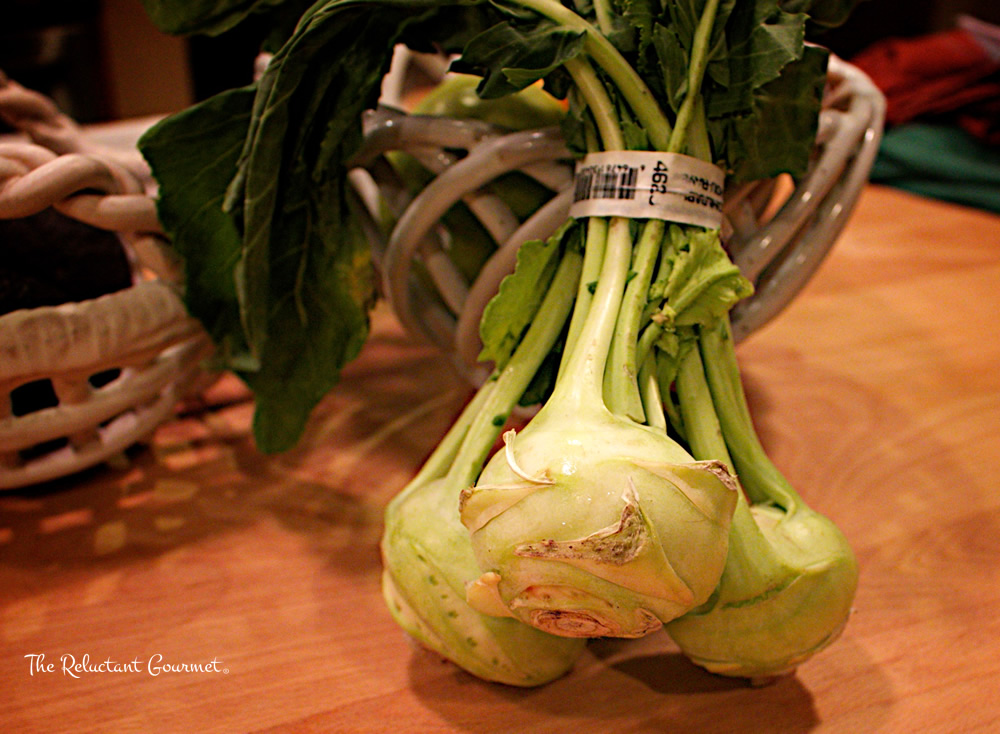
Root Vegetables
Root vegetables are edible plants that grow underground and are known for their rich nutrients and versatility in cooking. Common root vegetables include carrots, potatoes, sweet potatoes, beets, turnips, radishes, parsnips, and rutabagas. These vegetables are typically high in carbohydrates, which provide energy, and they are also good sources of dietary fiber, vitamins, and minerals.
Carrots, for instance, are rich in beta-carotene, which the body converts to vitamin A, essential for vision and immune function. Beets are known for their high folate, manganese, and antioxidants, which support overall health and help reduce inflammation. Potatoes and sweet potatoes are excellent sources of potassium, vitamin C, and various B vitamins.
Root vegetables are incredibly versatile in the kitchen. They can be roasted, boiled, mashed, sautéed, or eaten raw, and they add flavor, texture, and nutritional value to a wide range of dishes. Roasting root vegetables brings out their natural sweetness while boiling and mashing them create comforting and hearty sides. They are often used in soups, stews, salads, and casseroles.
This recipe uses kohlrabi, a root vegetable in the same family as cabbage, broccoli, and Brussels sprouts, in addition to potatoes, carrots, and onions. I don’t remember ever cooking with or eating kohlrabi, but it is a root vegetable.
Kohlrabi’s taste is similar to that of broccoli’s stem, only sweeter. I learned from my Facebook friends that it can be eaten cooked or raw, and the stems can be sautéed and served.
Braising Technique
If you are not familiar with braising, it is a technique where you slowly cook ingredients with a small amount of liquid in a covered pot in the oven or on the stovetop. It is a great technique for tough cuts of meat but is just as good with fish, poultry, or vegetables. You can learn more about braising in my post, How to Braise Everything.
This Recipe
This recipe was adapted from one we found in the newspaper and comes from Korean chef Hooni Kim, who has two restaurants in New York City. In the article, he recommends ” letting the dish rest before serving—overnight, if possible.”
I agree and find that many braises or slow-cooked meals taste better the next day. I also noticed this dish didn’t seem as hot the next day. Even though I say braising is a slow-cooked technique, this dish only takes 35 minutes to prepare and cook.
Yes, it is possible to “slow cook fast” when the ingredients are cut up into small pieces so they cook fast. It’s like a stir fry, but this dish is cooked in chicken stock instead of cooking it in oil.
One other exception: the original recipe does not call for covering the pot when cooking. I’m not sure if this disqualifies it from being a braise, but next time I prepare this dish, I will cover the pot right after I return the chicken to the pot and see if the results are the same or different.
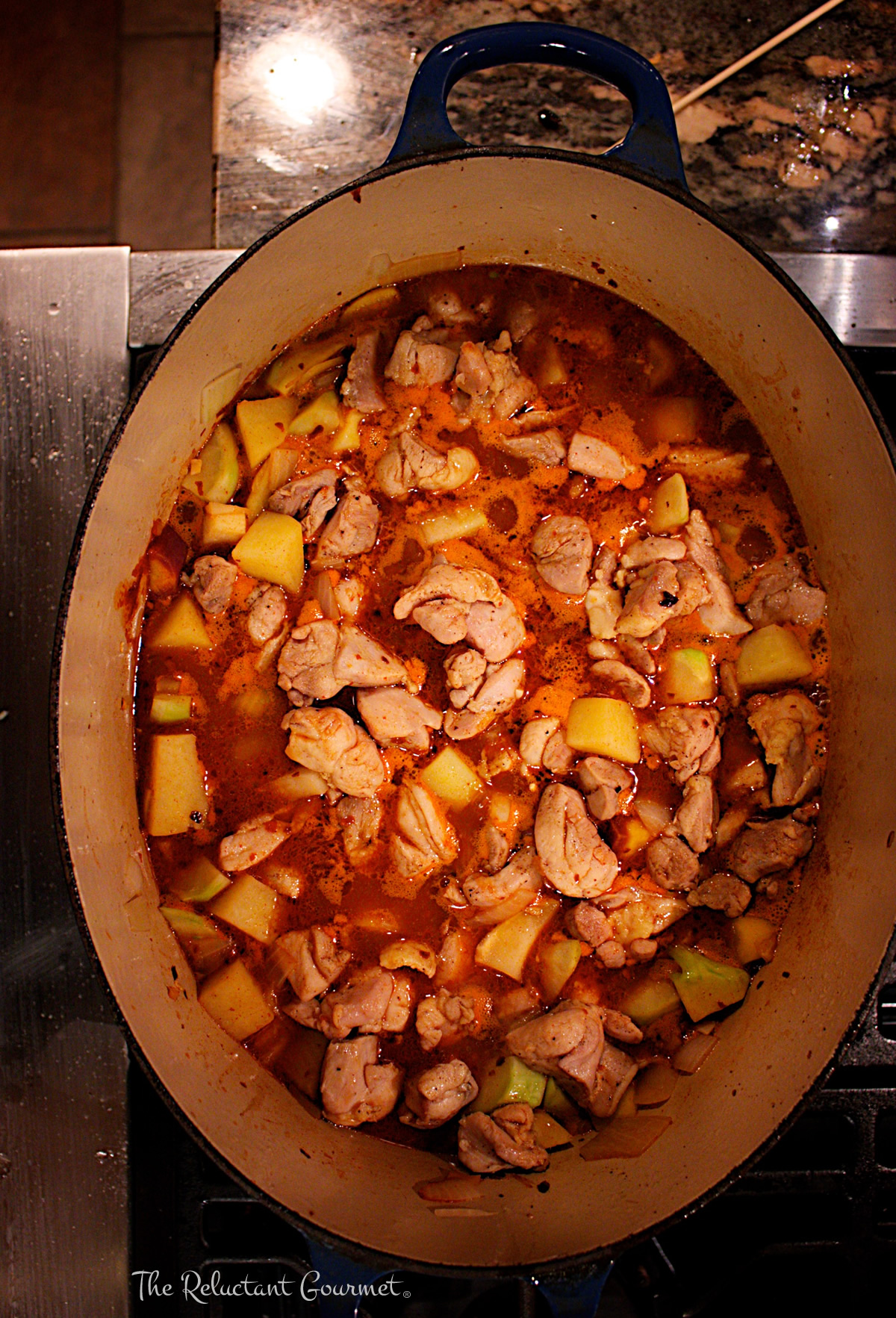
Spicy Braised Chicken Recipe
Ingredients
- 2½ pounds chicken thighs boneless skinless , cut up into bite-sized pieces
- salt and pepper freshly ground
- 2 tablespoons vegetable oil
- 2 medium potatoes peeled and chopped into bite-sized pieces
- 2 medium carrots peeled and chopped into bite-sized pieces
- 2 small kohlrabi peeled and chopped into bite-sized pieces
- 1 medium yellow onion finely chopped
- 1 tablespoon garlic minced
- 1 teaspoon fresh ginger minced
- 1 cup sake Japanese rice wine made from fermented rice
- 2 cups chicken stock
- 3 tablespoons gochujang
- 1 tablespoon red pepper flakes less to reduce spiciness
- 2 tablespoons soy sauce
- 1 tablespoon sugar
- 2 scallions thinly sliced for garnish (optional)
- cooked white rice for serving dish with
Instructions
- Start by heating a large Dutch oven or heavy bottomed pot over medium heat. While the pot is heating up, season the chicken with salt and pepper.
- Once the Dutch oven is hot, add oil and let it heat up some before adding the chicken pieces. Sear the chicken pieces until browned on all sides, about 5 minutes. Remove the chicken from the pot with a slotted spoon and reserve.
- Add the potatoes, carrots, kohlrabi, onions, garlic and ginger to the pot. Stir.
- Add the sake, raise the heat to high and scrape up any brown bits left in the pan from browning the chicken. Cook for a few minutes until the alcohol in the sake burns off.
- Add the chicken stock, gochujang, red pepper flakes, soy sauce and sugar. Give the pot a stir and bring it to a simmer, then reduce the heat to medium.
- Add the reserved chicken back into the pot, stir and continue cooking until the chicken is cooked through and the vegetables are tender. This should take about 15 minutes.
- Plating
- We served this dish in bowls because of the lovely, fragrant (spicy) broth the ingredients are cooked in.
- Add rice to the bowl, cover with chicken and vegetables and then spoon in some of the broth. Top with the sliced scallions and serve. Or if you can, wait a bit before serving to let all the flavors meld together and then serve.

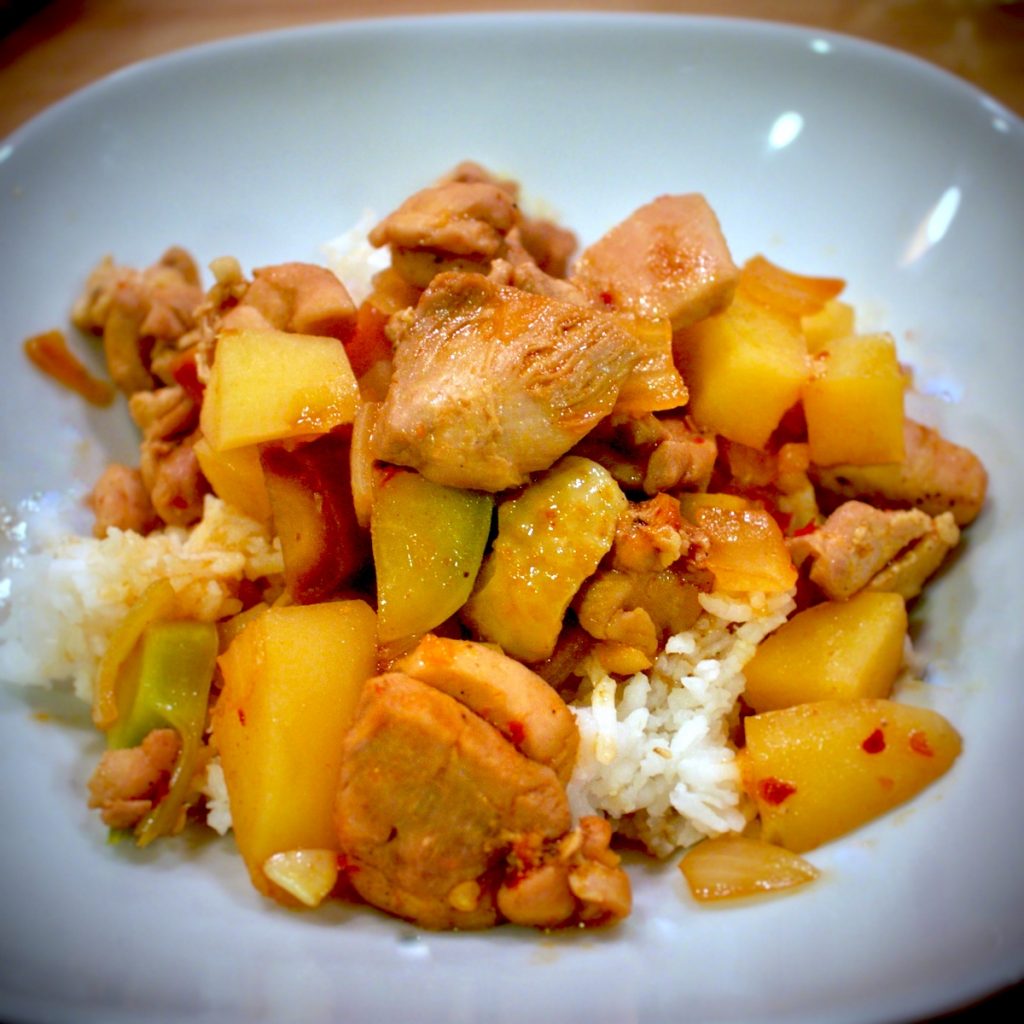
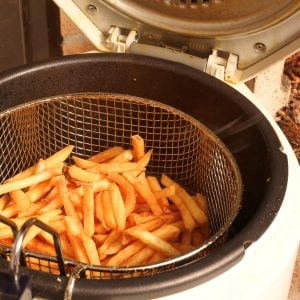
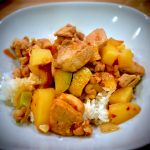



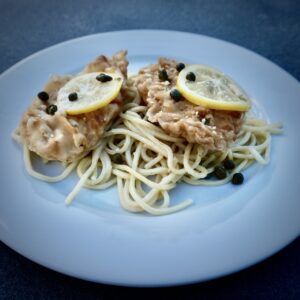
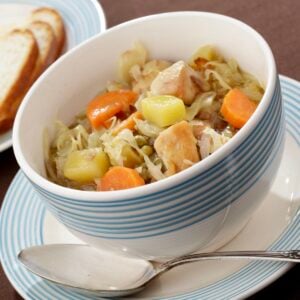

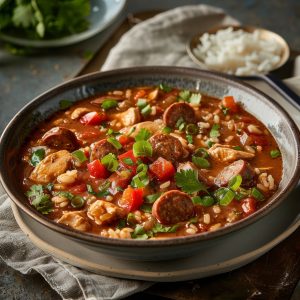
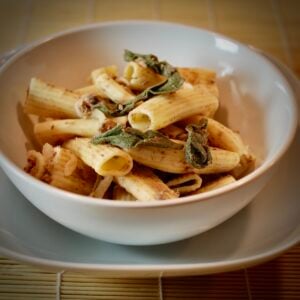


3 Responses
There is a lot more broth than you can see in this photo so that’s why I served it in bowls.
This looks absolutely delicious. And I, along with my husband, love, love spicy foods. This is something I’ll definitely have to try soon. Thanks for sharing. 🙂
I like hot food but this was just too hot. At first it make me cough from just putting my head over it. I got through it but if I make it again I will but the heat.